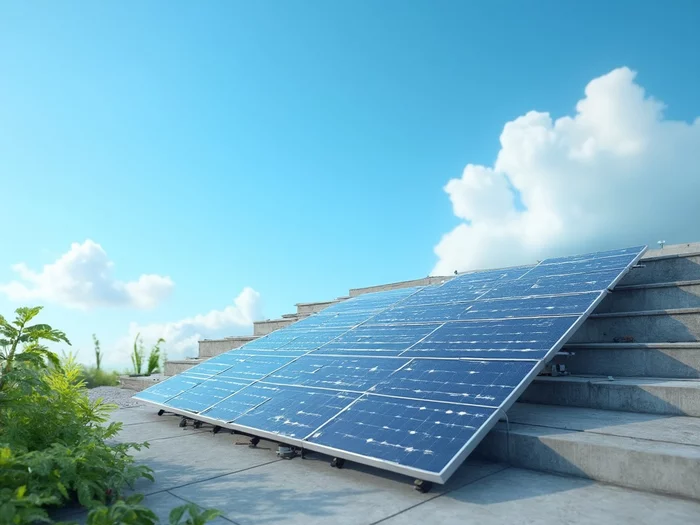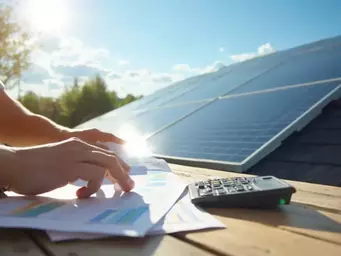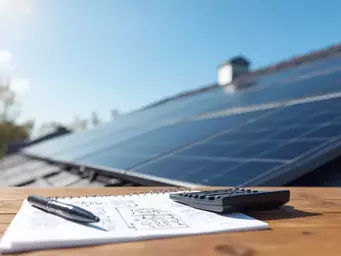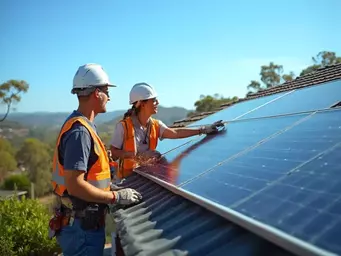Northern Hemisphere
Facing: South
Tilt Angle: 20° - 45°
Impact: Maximize direct sunlight exposure for optimal energy harvest.
Unlock expert insights on solar panel installation, energy savings, and government rebates for Australian homes and businesses. Join our community of informed solar enthusiasts!
Posted on: 2025-10-08
By: Evelyn Tran
As solar energy continues to gain traction, understanding how to optimize your solar panel orientation is more important than ever. Did you know that the right positioning can increase your energy efficiency by up to 20%? Let's dive into the essential factors that can help you maximize your solar investment!
Understanding how to orient your solar panels is crucial for maximizing energy output. This visual highlights key factors influencing efficiency based on hemisphere and practical considerations.
Facing: South
Tilt Angle: 20° - 45°
Impact: Maximize direct sunlight exposure for optimal energy harvest.
Facing: North
Tilt Angle: 20° - 45°
Impact: Crucial for maximizing energy output in regions like Australia.
Fixed Mounts: Lower cost, easier install.
Adjustable Mounts: Higher initial cost, greater long-term energy savings (e.g., 15-20% increase seen in case studies).
When it comes to maximizing energy output from your solar panels, orientation is key! The way you position your panels can significantly influence how much sunlight they capture, which directly affects your energy savings. In Australia, where we have plenty of sun, ensuring that your panels face the right direction can mean the difference between a good investment and a great one. It's essential both for homeowners and businesses to understand how orientation impacts their solar energy efficiency.
In my experience as a solar energy consultant at Longi Solar Solutions, I've seen how proper panel orientation can lead to substantial energy savings. Many people underestimate its importance, but getting it right is crucial for optimizing energy production and cost-effectiveness.
Correct solar panel orientation ensures you harness as much sunlight as possible. If your panels are not oriented properly, you could lose up to 20% of potential energy efficiency!
This is why understanding how to orient your panels based on your specific location and roof type is essential. Those who take the time to assess their orientation often find themselves enjoying greater benefits. For more insights into solar solutions and best practices, you can refer to the Best Practices Guidance for Solar and Zoning, which offers comprehensive information on maximizing solar benefits.
To make the most out of your solar system, it's crucial to understand two important concepts: tilt and azimuth angles. The tilt angle refers to the angle at which your solar panels are slanted in relation to the ground. Meanwhile, the azimuth angle indicates the compass direction that your panels face.
Understanding these angles helps make informed decisions about panel placement, ultimately leading to higher energy production. A well-designed orientation not only enhances efficiency but also prolongs the lifespan of your solar panels!
When considering solar panel orientation, geographical location plays a significant role. In the Northern Hemisphere, panels should generally face south. Conversely, in the Southern Hemisphere, such as Australia, they should face north to capture the most solar energy.
These considerations are vital for maximizing energy production. The differences in orientation are often overlooked, but they can significantly impact the overall efficiency of your solar system.
Here are some key orientation guidelines for optimal solar panel placement based on your hemisphere:
For Australian homeowners, understanding these guidelines can ensure that you're making the most of your investment in solar energy!
Another factor to consider is latitude. The ideal tilt angle increases as you move away from the equator, which means that homeowners in southern Australia may need to adjust their panels to capture maximum sunlight. Latitude influences how direct sunlight hits your panels, so it’s crucial to factor this in.
By understanding how your geographic latitude impacts tilt angles, you can make informed adjustments that enhance your solar system’s performance.
To further enhance the efficiency of your solar panels, consider installing a solar tracking system. These systems adjust the panels' position throughout the day to follow the sun's path, potentially increasing energy production by 25% or more compared to fixed systems. This investment can lead to greater savings in the long run!
When it comes to solar panel installation, understanding the nuances of solar panel orientation is crucial for maximizing energy output. A thorough site assessment is the first step in this process, helping you identify the best positioning for your panels. I often advise homeowners to consider their roof types, any shading issues, and other obstructions that could impact the orientation of their solar systems.
For instance, if your roof features a steep pitch, it may require different mounting solutions compared to a flat roof. Additionally, trees or nearby structures can cast shadows, reducing the efficiency of your panels. Taking the time to evaluate these factors can lead to significant increases in your system's performance.
Conducting a proper site assessment involves several key steps:
By following these steps, you can create a solid foundation for your solar panel installation. Remember, a well-planned installation can significantly enhance the efficiency of your system.
Once your solar panels are installed, keeping them optimized is essential. Here are some practical tips for maintaining optimal orientation and efficiency:
By implementing these maintenance tips, you can ensure your solar panels continue to perform at their best for years to come!
Here are some frequently asked questions about solar panel orientation and efficiency:
When considering solar mounting solutions, it's essential to weigh the economic pros and cons of both fixed and adjustable systems. While fixed mounts are generally less expensive and easier to install, adjustable mounts offer greater flexibility for optimizing energy output throughout the year.
From my experience at Longi Solar Solutions, I often see homeowners benefit significantly from adjustable systems, particularly in areas where sunlight varies greatly across seasons. Let’s break down some of the key factors to consider:
Here are some points to compare between fixed and adjustable solar mounting systems:
By evaluating these factors, you can make an informed decision that aligns with both your budget and energy goals. For additional guidance on solar power systems, including deployment and community benefits, the Solar Power in Your Community Guidebook is an excellent resource.
To illustrate the benefits of proper solar panel orientation, here are a few case studies from clients I've worked with:
These examples highlight the importance of thoughtful orientation and installation strategies for maximizing solar energy output.
As you consider solar energy solutions, understanding the available incentives can significantly impact your overall costs. In Australia, numerous programs exist to help homeowners and businesses transition to solar energy.
Here are some financial incentives you should explore:
By leveraging these incentives, you can reduce the initial investment required for solar panel installation, making it more affordable and attractive. For a comprehensive guide on going solar and the benefits involved, the Homeowner's Guide to Going Solar provides valuable information.
Understanding your energy consumption is critical for informing better solar panel configurations. Here are a few things to consider:
By assessing your energy needs accurately, you can ensure your solar system is designed for maximum efficiency and cost savings.
In summary, several key orientation factors can significantly affect the performance of your solar energy system. By considering roof type, shading, and the type of mounting system, you’ll be better equipped to maximize your energy output.
Here’s a quick recap of essential factors to keep in mind:
These strategies will help you optimize your solar panel placement and enhance your energy independence!
Now that you’re armed with this knowledge, I encourage you to assess your solar panel orientation! Taking action today can lead to improved energy output and savings for the future. If you have any questions or would like personalized advice, feel free to reach out to me at Longi Solar Solutions—we're here to help you every step of the way!
Here is a quick recap of the important points discussed in the article:

 Ready to unlock the potential of solar energy for your home? Understanding the financial landscape o
Ready to unlock the potential of solar energy for your home? Understanding the financial landscape o
 As you contemplate the shift to solar energy, consider this: a comprehensive understanding of the co
As you contemplate the shift to solar energy, consider this: a comprehensive understanding of the co
 Choosing the right solar installer can significantly impact your renewable energy journey. Are you r
Choosing the right solar installer can significantly impact your renewable energy journey. Are you r